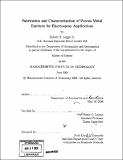Fabrication and characterization of porous metal emitters for electrospray applications
Author(s)
Legge, Robert S., Jr
DownloadFull printable version (43.71Mb)
Other Contributors
Massachusetts Institute of Technology. Dept. of Aeronautics and Astronautics.
Advisor
Paulo C. Lozano.
Terms of use
Metadata
Show full item recordAbstract
Electrospray thrusters provide small, precise thrust with high power efficiencies and variable specific impulses from less than 1000s to over 4000s. The miniaturization and clustering of many emitters together is essential to increase the thrust density of electrospray devices in order to increase their domain of applicability in space. Electrospray emitter arrays have many advantages over existing electric propulsion devices including much lower mass per unit thrust and much lower volume per unit thrust than conventional ion and hall devices. Additionally, with emitter clustering, the thrust density can meet and even exceed that of hall or ion thrusters. A method of micro-fabricating electrospray emitter arrays using modified conventional microfabrication technology is presented. The method is adaptable to different emitter materials and can be used to create ultra dense emitter arrays with microfabrication precision down to the micron level. One-dimensional linear emitter arrays with emitter separation as low as 500 [mu]m have been fabricated out of porous tungsten and preliminary tests show that dense two-dimensional emitter arrays can be fabricated with emitter separations down to 300[mu]m. Experimental research that was conducted to characterize emitter array performance is also presented. Time of flight mass spectrometry was used to identify the emitted ion species from the device, which showed that the device operates in the ion emission regime. Current was collected as a function of applied voltage to show that the devices were able to operate with emitted current levels of 0.5 - 1.5 [mu]A per emitter, even for dense arrays. Direct thrust measurements were performed to show that the amount of thrust attainable is on the order of 0.1 [mu]N per [mu]A of emitted current for extraction voltages of around 1900 V. (cont.) A normalization scheme was implemented to compare performance of emitter arrays of different density and initial results from a numerical model has shown that the emitters might be limited by fluid transport.
Description
Thesis (S.M.)--Massachusetts Institute of Technology, Dept. of Aeronautics and Astronautics, 2008. Includes bibliographical references (leaves 137-140).
Date issued
2008Department
Massachusetts Institute of Technology. Department of Aeronautics and AstronauticsPublisher
Massachusetts Institute of Technology
Keywords
Aeronautics and Astronautics.